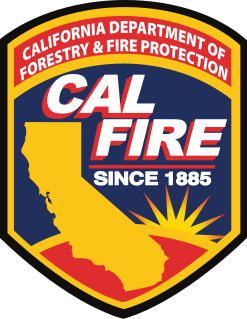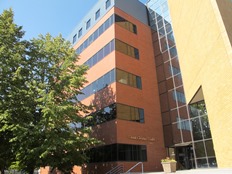An urban growth boundary, or UGB, is a regional boundary, set in an attempt to control urban sprawl by, in its simplest form, mandating that the area inside the boundary be used for urban development and the area outside be preserved in its natural state or used for agriculture. Legislating for an "urban growth boundary" is one way, among many others, of managing the major challenges posed by unplanned urban growth and the encroachment of cities upon agricultural and rural land.
Land-use planning is the process of regulating the use of land by a central authority. Usually, this is done in an effort to promote more desirable social and environmental outcomes as well as a more efficient use of resources. More specifically, the goals of modern land-use planning often include environmental conservation, restraint of urban sprawl, minimization of transport costs, prevention of land use conflicts, and a reduction in exposure to pollutants. In the pursuit of these goals, planners assume that regulating the use of land will change the patterns of human behavior, and that these changes are beneficial. The first assumption, that regulating land-use changes the patterns of human behavior is widely accepted. However, the second assumption - that these changes are beneficial - is contested, and depends on the location and regulations being discussed.

James Douglas McKay was an American businessman and politician from the U.S. state of Oregon. He served in World War I before going into business, where he was most successful as a car dealership owner in Salem. A Republican, he served as a city councilor and mayor of Salem before election to the Oregon State Senate. McKay served four terms in the state senate, also served stateside with the rank of major in the U.S. Army during World War II, and was then elected as the twenty-fifth governor of Oregon in 1948. He left that office before the end of his term when he was selected as the thirty-fifth U.S. Secretary of the Interior during the Eisenhower administration.

A metropolitan planning organization (MPO) is a federally mandated and federally funded transportation policy-making organization in the United States that is made up of representatives from local government and governmental transportation authorities. They were created to ensure regional cooperation in transportation planning. MPOs were introduced by the Federal-Aid Highway Act of 1962, which required the formation of an MPO for any urbanized area (UZA) with a population greater than 50,000. Federal funding for transportation projects and programs are channeled through this planning process. Congress created MPOs in order to ensure that existing and future expenditures of governmental funds for transportation projects and programs are based on a continuing, cooperative, and comprehensive ("3-C") planning process. Statewide and metropolitan transportation planning processes are governed by federal law. Transparency through public access to participation in the planning process and electronic publication of plans now is required by federal law. As of 2015, there are 408 MPOs in the United States.
The Heritage Conservation and Recreation Service (HCRS) was an agency within the United States Department of the Interior which subsumed its functions from the National Park Service and Bureau of Outdoor Recreation. It was created under the Carter administration by order of the Secretary of the Interior on January 25, 1978. HCRS, a non-land managing agency, was responsible for assuring the identification, protection, and beneficial use of important cultural, natural, and recreational American resources. HCRS offered grant assistance, technical information and guidance to those in the public and private sectors involved in conservation or recreation projects. Under the Reagan administration the HCRS was abolished by Secretarial Order 3060 on February 19, 1981, and absorbed into the National Park Service.

The California Department of Forestry and Fire Protection is a fire department of the California Natural Resources Agency in California, United States. It is responsible for fire protection in various areas under state responsibility totaling 31 million acres, as well as the administration of the state's private and public forests. In addition, the department provides varied emergency services in 36 of the state's 58 counties via contracts with local governments. The department's director is Thom Porter, who was appointed by Governor of California Gavin Newsom.

The Wisconsin Department of Natural Resources (WDNR) is a government agency of the U.S. state of Wisconsin charged with conserving and managing Wisconsin's natural resources. The Wisconsin Natural Resources Board has the authority to set policy for the WDNR. The WDNR is led by the Secretary, who is appointed by the Governor of Wisconsin. The WDNR develops regulations and guidance in accordance with laws passed by the Wisconsin Legislature. It administers wildlife, fish, forests, endangered resources, air, water, waste, and other issues related to natural resources. The central office of the WDNR is located in downtown Madison, near the state capitol.

The Michigan Department of Natural Resources (DNR) is the agency of the state of Michigan charged with maintaining natural resources such as state parks, state forests, and recreation areas. It is governed by a director appointed by the Governor and accepted by the Natural Resources Commission. Currently the Director is Daniel Eichinger. The DNR has about 1,400 permanent employees, and over 1,600 seasonal employees.
The Oregon Business Development Department (OBDD) dba Business Oregon is a government agency of the U.S. state of Oregon, providing support of economic and community development and cultural enhancement through administration of a variety of programs of incentives, financial support, and technical assistance to businesses, nonprofit organizations and community groups, industries, and local and regional governments and districts.

The Oregon Department of Agriculture (ODA) is the agency of the government of the U.S. state of Oregon responsible for promoting and regulating food production and safety. It is headed by the director of agriculture, appointed by the governor of Oregon subject to senate confirmation, advised by a board of ten members, also gubernatorial appointees. Through its nine divisions, it administers no fewer than 36 chapters of Oregon laws.
The Oregon Department of Environmental Quality (DEQ) is the chief regulatory agency of the government of the U.S. state of Oregon responsible for protecting and enhancing the state's natural resources and managing sanitary and toxic waste disposal. The agency employs approximately 700 scientists, engineers, technicians, administrators, and environmental specialists. It has headquarters in Portland, regional administrative offices in Bend, Eugene, and Portland; and field offices in Coos Bay, Medford, Pendleton, Salem, and The Dalles. The Laboratory and Environmental Assessment Division operates an environmental laboratory in Hillsboro. The agency's director has the authority to impose fines for violations of the state's anti-pollution laws. In addition to its state mandate, the United States Environmental Protection Agency (EPA) has delegated authority to DEQ to administer federal environmental programs including the federal Clean Air Act, Clean Water Act, and Resource Conservation and Recovery Act within the state.

The Oregon Housing and Community Services Department (OHCS) is the housing finance agency of the government of the U.S. state of Oregon. It administers programs providing financing assistance for single family homes, new construction or rehabilitation of multi-family affordable housing developments, and grants and tax credits to promote affordable housing. Prior to 1991, when the Oregon Legislative Assembly merged the Housing Agency with State Community Services forming OHCS to eliminate duplicative costs and provide better coordination of related activities, financing and service programs were operated separately.

The Oregon Public Utility Commission (PUC) is the chief electric, gas and telephone utility regulatory agency of the government of the U.S. state of Oregon. It sets rates and establishes rules of operation for the state's investor-owned utility companies. With respect to publicly owned utility districts and cooperatives, its authority is limited to safety regulations.

The Hawaiʻi Department of Land and Natural Resources (DLNR) is a part of the Hawaiʻi state government dedicated to managing, administering, and exercising control over public lands, water resources and streams, ocean waters, coastal areas, minerals, and other natural resources of the State of Hawaiʻi. The mission of the Hawaiʻi Department of Land and Natural Resources is to "enhance, protect, conserve and manage Hawaiʻi's unique and limited natural, cultural and historic resources held in public trust for current and future generations of the people of Hawaiʻi nei, and its visitors, in partnership with others from the public and private sectors." The organization oversees over 1.3 million acres of land, beaches, and coastal waters and 750 miles of coastal land.
The Pennsylvania Department of Environmental Protection (DEP) is the agency in the U.S. state of Pennsylvania responsible for protecting and preserving the land, air, water, and public health through enforcement of the state's environmental laws. It was created by Act 18 of 1995, which split the Department of Environmental Resources into the Department of Environmental Protection and the Department of Conservation and Natural Resources. Its current secretary is Patrick McDonnell.

Land use in Oregon concerns the evolving set of laws affecting land ownership and its restrictions in the U.S. state of Oregon.

The Oregon Board of Forestry is responsible for forest policy and oversight of forest management practices within the state of Oregon. The board appoints the state forester and oversees the Oregon Department of Forestry. The board also works with private land owners and the Federal Government to promote consistent forest management policies throughout the state.
The Oregon Land Conservation and Development Act of 1973, formally Oregon Senate Bills 100 and 101 of 1973, were pieces of landmark legislation passed by the Oregon State Senate in 1973 and later signed into law. It created a framework for land use planning across the state, requiring every city and county to develop a comprehensive plan for land use.

The Willamette River Greenway is a cooperative state and local government effort to maintain and enhance the scenic, recreational, historic, natural and agricultural qualities of the Willamette River and its adjacent lands. A number of trails exist along the greenway, but significant gaps still exist.












